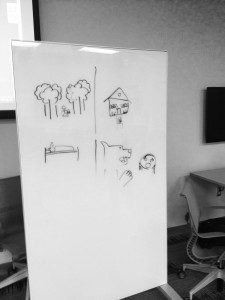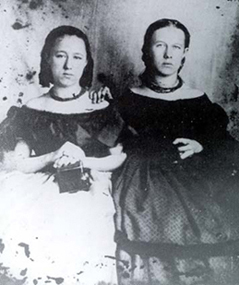I chose to live tweet entries from Shadows on My Heart: The Civil War Diary of Lucy Rebecca Buck of Virginia for this assignment. Lucy was 19 at the time she wrote the entries that I covered. She was a member of the small planter class in Front Royal, Virginia where she lived at her family’s plantation, Bel Air. Since Lucy’s entries in her diary from exactly 150 to 153 years ago were too sparse for me to effectively cover given the time constraints, I decided to live tweet her entries from January 27 to February 5, 1862. This section of her diary provided me with close to a daily supply of entries.
I started with Lucy’s entry from January 27 because it provides a fascinating window into Lucy’s ambivalence towards gender standards. In this entry, Lucy was caught up in the tensions created by social understandings of gender. Her two male guests hotly debated female education, which Lucy was a proponent of. As a hostess, Lucy chose to follow social conventions by changing the subject instead of defending female education and gaining a reputation as a free-thinking, unfeminine, young woman. The next two entries demonstrated the profound impact of a lack of accessible communication technology on Lucy. Both entries were filled with an undertone of anxiety because she had not heard from her brothers in the Confederate army. Writing letters was the only available form of communication between Lucy and her brothers. I especially enjoyed the juxtaposition of this protracted apprehension over a lack of communication with the instantaneousness of Twitter as a modern communication technology. The next several entries revealed Lucy’s emotional ambivalence characteristic of those who remained on the home front during the war: she was overjoyed at having her brothers home while simultaneously feeling melancholy about them having to leave again. The final entry returns to Lucy’s feelings of anxiety for her brothers since she has no quick way of communicating with them to find out where they are or what they are doing –a feeling almost foreign to us today with Twitter, Facebook, Tumblr, Pinterest, Instagram, text messaging, etc.
I tried to capture the overall topics and emotions of Lucy’s diary entries. However, I chose to write the tweets using informal, contemporary language including hashtags. I also modernized Lucy’s spelling and tweeted using my account instead of creating one for Lucy. I included the dates of Lucy’s entries in my tweets to provide additional structure and clarification against the dates of my tweets on Twitter. I did these things as a creative exercise in an attempt to imagine myself as Lucy, tweeting about her American Civil War experiences in 2014.
Sources:
Buck, Lucy Rebecca. Shadows on My Heart: The Civil War Diary of Lucy Rebecca Buck of Virginia. Southern Voices from the Past. Athens, GA: University of Georgia Press, 1997.
“Lucy and Nellie Buck.” Photograph. Front Royal, Virginia: Warren Heritage Society, c 1860. From Head Quarters 13th Regt. Rifles, Mass. Vol. , To Front Royal and Back. http://www.13thmass.org/1862/front_royal.html (accessed October 15, 2014).
Other sources that have influenced my thinking about Lucy:
Clinton, Catherine. Tara Revisited: Women, War & the Plantation Legend. 1st ed. New York: Abbeville Press, 1995.
Edwards, Laura F. Scarlett Doesn’t Live Here Anymore: Southern Women in the Civil War Era. Urbana and Chicago: University of Illinois Press, 2000.
Faust, Drew Gilpin, and NetLibrary, Inc. Mothers of Invention Women of the Slaveholding South in the American Civil War. Fred W. Morrison Series in Southern Studies. Chapel Hill: University of North Carolina Press, 1996.
Fox-Genovese, Elizabeth. Within the Plantation Household. Chapel Hill and London: University of North Carolina Press, 1988.
Groh, Mary Lou. “Maria “Belle” Boyd.” The Civil War Trust. http://www.civilwar.org/education/history/biographies/maria-belle-boyd.html (accessed April 16, 2014).
Ott, Victoria E. Confederate Daughters: Coming of Age During the Civil War. Carbondale: Southern Illinois University Press, 2008.
Rable, George C. Civil Wars: Women and the Crisis of Southern Nationalism. Urbana and Chicago: University of Illinois Press, 1989.
Roberts, Giselle. The Confederate Belle. Columbia: University of Missouri Press, 2003.


